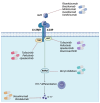The IL-23R and Its Genetic Variants: A Hitherto Unforeseen Bridge Between the Immune System and Cancer Development
- PMID: 39796684
- PMCID: PMC11718844
- DOI: 10.3390/cancers17010055
The IL-23R and Its Genetic Variants: A Hitherto Unforeseen Bridge Between the Immune System and Cancer Development
Abstract
IL-23R (interleukin-23 receptor), found on the surface of several immune cells, plays a key role in the immune system. Indeed, this process is not limited to the inflammatory response but also plays a role in the adaptive immune response. The binding between IL-23R and its specific ligand, the interleukin 23, initiates a number of specific signals by modulating both properties and behavior of immune cells. In particular, it is critical for the regulation of T helper 17 cells (Th17). Th17s are a subset of T cells involved in autoimmune and inflammatory diseases, as well as in cancer. The clinical relevance of IL-23R is underscored by its association with an elevated susceptibility or diminished vulnerability to a spectrum of diseases, including psoriasis, ankylosing spondylitis, and inflammatory bowel disease (IBD). Evidence has emerged that suggests it may also serve to predict both tumor progression and therapeutic responsiveness. It is noteworthy that the IL-23/IL-23R pathway is emerging as a promising therapeutic target. A number of biologic drugs, such as monoclonal antibodies, are currently developing with the aim of blocking this interaction, thus reducing inflammation. This represents a significant advancement in the field of medicine, offering new hope for pursuing more effective and personalized treatments. Recent studies have also investigated the role of such a pathway in autoimmune diseases, and its potential impact on infections as well as in carcinogenesis. The aim of this review is to focus on the role of IL-23R in immune genetics and its potential for modulating the natural history of neoplastic disease.
Keywords: IL-23R; Th17; genetic variants; immune cells; tumor microenvironment.
Conflict of interest statement
The authors declare no conflicts of interest.
Figures





Similar articles
-
Protective role of R381Q (rs11209026) polymorphism in IL-23R gene in immune-mediated diseases: A comprehensive review.J Immunotoxicol. 2016 May;13(3):286-300. doi: 10.3109/1547691X.2015.1115448. Epub 2016 Apr 4. J Immunotoxicol. 2016. PMID: 27043356 Review.
-
Lnc-ITSN1-2, Derived From RNA Sequencing, Correlates With Increased Disease Risk, Activity and Promotes CD4+ T Cell Activation, Proliferation and Th1/Th17 Cell Differentiation by Serving as a ceRNA for IL-23R via Sponging miR-125a in Inflammatory Bowel Disease.Front Immunol. 2020 May 28;11:852. doi: 10.3389/fimmu.2020.00852. eCollection 2020. Front Immunol. 2020. PMID: 32547537 Free PMC article.
-
Clinical and Histopathological Amelioration of Experimental Autoimmune Encephalomyelitis by AAV Vectors Expressing a Soluble Interleukin-23 Receptor.Neurotherapeutics. 2017 Oct;14(4):1095-1106. doi: 10.1007/s13311-017-0545-8. Neurotherapeutics. 2017. PMID: 28593439 Free PMC article.
-
Investigation of association of the IL-12B and IL-23R genetic variations with psoriatic risk in a South Indian Tamil cohort.Hum Immunol. 2016 Jan;77(1):54-62. doi: 10.1016/j.humimm.2015.10.006. Epub 2015 Oct 20. Hum Immunol. 2016. PMID: 26472011
-
Rs-10889677 variant in interleukin-23 receptor may contribute to creating an inflammatory milieu more susceptible to bladder tumourigenesis: report and meta-analysis.Immunogenetics. 2021 Jun;73(3):207-226. doi: 10.1007/s00251-021-01205-w. Epub 2021 Mar 4. Immunogenetics. 2021. PMID: 33665735 Review.
Cited by
-
Gene Expression Changes as Biomarkers of Immunosenescence in Bulgarian Individuals of Active Age.Biomedicines. 2025 Mar 15;13(3):721. doi: 10.3390/biomedicines13030721. Biomedicines. 2025. PMID: 40149697 Free PMC article.
-
Gut-heart axis: cardiac remodeling and heart failure in the context of inflammatory bowel disease and dysbiosis.Am J Physiol Gastrointest Liver Physiol. 2025 Jul 1;329(1):G122-G137. doi: 10.1152/ajpgi.00016.2025. Epub 2025 May 19. Am J Physiol Gastrointest Liver Physiol. 2025. PMID: 40387516 Free PMC article. Review.
-
Multiplex immunofluorescence assessment of macrophages and IL-23R in inflammatory and malignant diseases of the oral mucosa: a pilot study.Front Immunol. 2025 Apr 14;16:1569490. doi: 10.3389/fimmu.2025.1569490. eCollection 2025. Front Immunol. 2025. PMID: 40297579 Free PMC article.
References
-
- Parham C., Chirica M., Timans J., Vaisberg E., Travis M., Cheung J., Pflanz S., Zhang R., Singh K.P., Vega F., et al. A Receptor for the Heterodimeric Cytokine IL-23 Is Composed of IL-12Rbeta1 and a Novel Cytokine Receptor Subunit, IL-23R. J. Immunol. 2002;168:5699–5708. doi: 10.4049/jimmunol.168.11.5699. - DOI - PubMed
Publication types
Grants and funding
LinkOut - more resources
Full Text Sources
Research Materials

